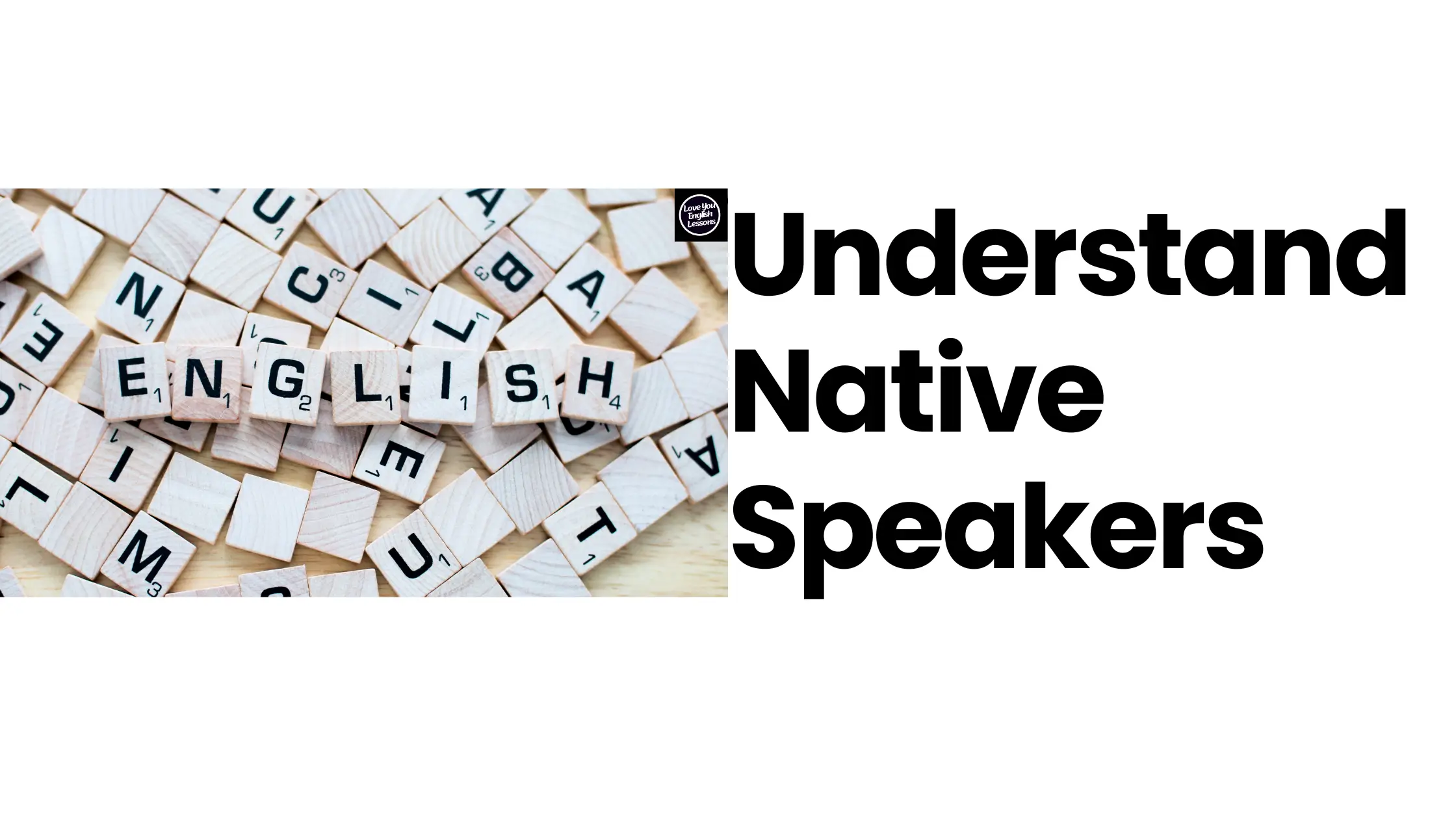How to Understand Native English Speakers
In this blog, I will give you some tips for understanding native speakers.
Do you get frustrated that you still don’t understand native speakers even though you consider yourself fluent in English?
One of the most common questions that my students ask is why do I understand you, but I don’t understand native speakers?
You think your English is good until you listen to native speakers. It may sound like they’re speaking another language that can be so frustrating.
I will give you some tips that will help you understand native speakers more easily.
Why are English teachers easier to understand? There are several reasons.
Experienced language teachers are always thinking about the needs and the skill levels of their students.
They typically speak more slowly and clearly. Additionally, teachers use vocabulary. It is appropriate to the student’s English level.
For example, when I’m teaching an advanced English class, I may use more advanced vocabulary and I may use more expressions than what I’m teaching intermediate students.
But the reality is most native speakers don’t speak the way English teachers do, and you need to understand other native speakers.
So let me give you, my tips.
My first recommendation is to pay attention to idea clusters rather than individual words.
What exactly are thinking groups?
Thought groups are grammatical units made up of words that naturally belong together.
Let’s look at this sentence.
What are you talking about? 5 words.
However, when we utter the statement, it sounds like a single word. All the words are connected, there is no break between them.
We stress talking because that’s the keyword. But all of the other words are spoken very quickly.
Let’s prolong the awe, the vowel sound in talking.
What are you talking about?
You don’t need to understand all of the little words in English. The key words are stressed. These words are called content words.
They’re the words with the most meaning, and they’re usually nouns and verbs.
The other little words around the content words are called function words.
They are prepositions, pronouns, articles and conjunctions, and sometimes adjectives. Function Words don’t carry much meaning.
So, when you’re listening to native speakers, pay attention to the content words.
You don’t need to understand every little word. Pay attention to the stress of words and connected speech.
Remember, native speakers speak in thought groups. Let’s look at this sentence.
Also read:
- How to Develop Powerful Vocabulary
- 5 Must Know English Slang Terms
- Expand English Vocabulary Fast
- English Slang Words Guide 2024
- How to Build English Vocabulary: 10 Tips for Success
I don’t know what he’s talking about. 8 words.
Two thought groups. Because it’s a short sentence. You can say in one breath, I don’t know what he’s talking about.
We’re going to stress no and talking.
I don’t know what he’s talking about.
We don’t stress “I” or “he is” or “about”.
Let’s look at a few more sentences.
I don’t understand it.
We stress the final syllable of understand it is going to be bigger.
Have you heard about it?
We stress heard. That’s a verb. That’s the word that carries the most meaning.
When you are paying attention to native speakers, take note of that sample to help you understand them.
Let’s look at a conditional sentence.
If you hadn’t told me, I wouldn’t have known about it.
We have two thought groups, and because the sentence is a little bit longer, we can pause.
So, we say the first part in one breath as one word. We don’t pause.
If you hadn’t told me, and then we say, I wouldn’t have known about it.
We stress told and known. Those are the main words.
We hear the rest of the words are spoken very quickly. It’s normal that you don’t hear the other words clearly.
This doesn’t mean your listening skills are not good. Other words are simply swallowed up.
They’re spoken very quickly. I recommend that you keep practicing this way.
Let’s go on to my next tip.
My next tip is don’t try to understand people. It is a very advanced skill to be able to understand all different types of native speakers. If you try to do this, you may feel frustrated with your English level. Be aware of who you’re listening to. Different types of people speak differently, use different expressions.
Different slang and often different generations speak differently.
So, ask yourself who do you want to understand? What would benefit you the most, is it work-related?
Choose to listen to the type of people you want to understand and don’t be discouraged if you can’t understand all native speakers. Some people are easier to understand than others.
Let me give you an example from my life.
When I was learning English, at that time in my life I was obsessed with speaking English and still I am.
Well, I still practice. From time to time, I listen to different English speakers online, and sometimes I feel really good about my ability to understand native speakers of English.
And other times I get discouraged. And I think, wow, Manoj, you’re not as advanced as you thought.
For example, when I listen to the President of the US, Joe Biden, I feel that my English level is very good. He speaks very clearly.
But then when I listen to popular rappers, I think oh my gosh my English is not that good. What are they talking about? They are using a lot of slang and a lot of expressions.
A president of a country is going to be using different vocabulary, different language than a young rapper, right?
Focus on a speaking style, age group, or topic of interest.
Then, gradually, you can expand on that topic and start listening to other topics that interest you.
So, if you would like to work in an English-speaking environment, listen to the topics. Related to your specialty.
My next tip is to choose one type of English accent to practice listening to. Maybe it’s the American accent, maybe it’s the British accent or Australian.
There are many different accents and there are many regional dialects of English, so it’s not realistic to try to understand all of them.
And remember, even native speakers sometimes struggle to understand other native speakers, and that probably happens in your language too.
To people in different parts of your country speak differently.
So, when someone visits your city from another part of the country, you’ll immediately know that they’re not from your area, right?
Maybe their melody is different, or they speak more quickly, or they pronounce certain words differently.
So, you should not expect yourself to be able to understand all native speakers of English.
If you would like to focus on American English, you will probably be learning. The standard American accent. It’s the accent spoken by the majority of Americans.
It’s also sometimes known as General American accent. It’s not typically associated with any particular region of the country.
It’s also called a neutral accent. It’s the most common one you will hear in the United States.
My next tip is to keep learning English expressions and idioms. The main difference between the English of a native speaker and a non-native speaker is that even the most advanced non-native speakers generally use a lot fewer expressions.
That’s also the easiest way to recognize a non-native speaker’s writing.
For example, if I’m reading a comment online, I can often recognize whether it’s written by a non- native speaker or by a native speaker. The non-native speaker uses a lot fewer expressions.
For example, a non-native speaker might say there is intense competition in that industry.
But a native speaker might say there is cutthroat competition in that industry.
What is cutthroat?
You understand the word cut and you understand the word throat. But if cutthroat doesn’t make sense in a sentence, that means it’s probably an expression.
And cutthroat means very intense, very aggressive.
When you’re listening to native speakers, you will hear a lot of words that don’t make sense. You understand the meaning of the words, but they don’t make sense in a sentence.
That means it’s probably an expression. The more expressions you know, the better you will be able to understand the conversations of native speakers.
Let’s look at these two words cold Turkey.
Do you know what that means?
You know the meaning of both of those words. You know the meaning of a cold, and you know the meaning of Turkey.
But what is cold Turkey?
Let’s understand how some native speakers used cold Turkey.
Peter, you’ve got to go cold Turkey.
No texts, no Facebook postings. Cold Turkey, 48 hours.
It must be an idiom because it’s meaningless. If you hear something similar and don’t understand it, you need to look up the meaning.
That’s a really important tip. Find out the meaning. Always keep expanding your knowledge of expressions.
Let’s look it up in Google to go cold Turkey.
It means to stop doing or using something suddenly and completely. Usually refers to the consumption of drugs, alcohol or tobacco. It can also refer to any bad habits.
Let’s look at some sample sentences.
- I’ve been trying to quit smoking for several years, using nicotine patches, gum, and even hypnotherapy.
Ultimately, I had to give in cold turkey and rely on my own willpower.
- I ate too much junk food and gained a lot of weight as a result.
Eventually, I went cold turkey and stopped buying anything other than healthy food.
Now you understand what those people were talking about.
Let’s look at a few more words that don’t make sense.
Let’s look at the expression “hold your horses”.
Alright, now this side. Hold your horses. But I said, “wait a minute”. Whoa, whoa, whoa, hold your horses.
You know what hold means.
And you know what horses means. But what is hold your horses?
Let’s find out the meaning from Google.
Holding your horses means waiting a moment. Used to tell someone to stop and think carefully about their decision or opinion about something.
Now let’s read the example sentence.
Hold your horses, Bill, let’s think about this for a moment. You must continue to do this.
Every time you hear somebody say something that doesn’t make sense, you understand the individual words.
But when they say the sentence, you have no idea what they’re talking about. They’re probably using an idiomatic expression.
So first, find out the meaning, second, you find some sample sentences online. And 3rd, and this is very important, make your own sample sentences.
This way, you will be more likely to remember the expression and use it the next time you speak English.
My next tip is to listen more than once. Listen to the same material many times. The first time you listen it’ll be difficult for you to understand, but each time you listen to it, you will be able to.
Understand more and new expressions will be imprinted in your mind. You will be able to memorize them, and your confidence will increase.
My next tip is to listen to topics you like. Listen to something that excites you, something that naturally interests you.
Studies have shown that when students are interested in something, they will learn more quickly and they will remember the information better.
This is because when you’re more passionate about something, you’re more likely to be focused.
And to be motivated to learn it, you want to find out as much as you can about the subject, so you will naturally want to look up the new expressions and the new words.
So, if you would like to improve your listening skills quickly, find a topic that you’re really passionate about.
My next tip is to use something that contains both an audio and a text.
For example, you can find a TV script online, and then when you watch the TV show, you can follow, paying attention to how they’re pronouncing things.
Or if you’re listening to an audiobook, get the physical book in both versions, then listen to one section, maybe 3 or 4 minutes, and listen to that section over and over again.
I recommend listening to the text first, then listening again without the text, then testing yourself. Ask yourself, what did I understand without seeing the text?
Then listen to the same text a few days later and you’ll be surprised. You’ll be able to understand a lot more and you will start to notice patterns of word stress and word reduction and so on.
And my final tip is to be patient if you don’t always understand native speakers, don’t get discouraged. Apply these techniques that I gave you and I promise you that you will get results.
Keep practicing and you will be surprised at how much your listening skills improve. And don’t forget to have fun in the process.
Got any other tips? Let me know in the comment.






